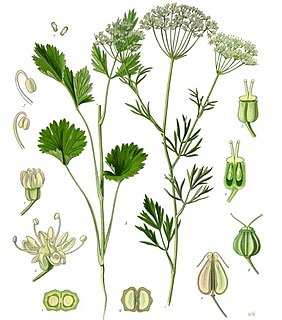
Sambuca is an Italian anise-flavoured, usually colourless, liqueur. Its most common variety is often referred to as white sambuca to differentiate it from other varieties that are deep blue in colour or bright red. Like other anise-flavoured liqueurs, the ouzo effect is sometimes observed when combined with water.

Caraway, also known as meridian fennel and Persian cumin, is a biennial plant in the family Apiaceae, native to western Asia, Europe, and North Africa.

Illicium verum is a medium-sized evergreen tree native to northeast Vietnam and southwest China. A spice commonly called star anise, staranise, star anise seed, Chinese star anise, or badiane that closely resembles anise in flavor is obtained from the star-shaped pericarps of the fruit of I. verum which are harvested just before ripening. Star anise oil is a highly fragrant oil used in cooking, perfumery, soaps, toothpastes, mouthwashes, and skin creams. About 90% of the world's star anise crop is used for extraction of shikimic acid, a chemical intermediate used in the synthesis of oseltamivir (Tamiflu).

Liquore Galliano L'Autentico, known more commonly as Galliano, is a sweet herbal liqueur, created in 1896 by Italian distiller and brandy producer Arturo Vaccari of Livorno, Tuscany and named after Giuseppe Galliano, an Italian hero of the First Italo-Ethiopian War.
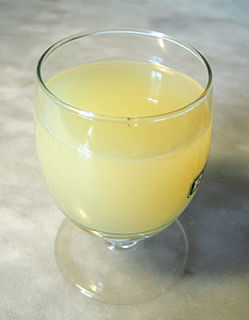
Pastis is an anise-flavoured spirit and apéritif from France, typically containing less than 100 g/l sugar and 40–45% ABV.
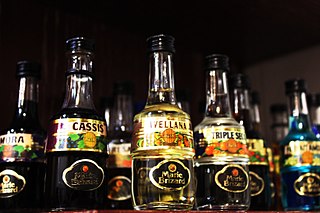
Anisette, or Anis, is an anise-flavored liqueur that is consumed in most Mediterranean countries, mainly in Spain, Italy, Portugal, Turkey, Greece, Lebanon, Cyprus, Israel, and France. It is colorless, and because it contains sugar, is sweeter than dry anise flavoured spirits. The most traditional style of anisette is that produced by means of distilling aniseed, and is differentiated from those produced by simple maceration by the inclusion of the word distilled on the label. And while Pastis is a similar-tasting liqueur that is prepared in similar fashion and sometimes confused with anisette, it employs a combination of both aniseed and licorice root extracts. Sambuca is essentially an anisette of Italian origin that requires a high minimum (350g/l) sugar content.

Anethole is an organic compound that is widely used as a flavoring substance. It is a derivative of phenylpropene, a type of aromatic compound that occurs widely in nature, in essential oils. It contributes a large component of the odor and flavor of anise and fennel, anise myrtle (Myrtaceae), liquorice (Fabaceae), camphor, magnolia blossoms, and star anise (Illiciaceae). Closely related to anethole is its isomer estragole, abundant in tarragon (Asteraceae) and basil (Lamiaceae), that has a flavor reminiscent of anise. It is a colorless, fragrant, mildly volatile liquid. Anethole is only slightly soluble in water but exhibits high solubility in ethanol. This trait causes certain anise-flavored liqueurs to become opaque when diluted with water, the ouzo effect.
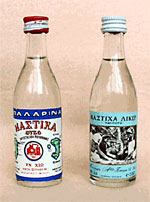
Mastika is a liqueur seasoned with mastic, a resin with a slightly pine or cedar-like flavor gathered from the mastic tree, a small evergreen tree native to the Mediterranean region.
Xtabentún is an anise liqueur made in Mexico's Yucatán region from anise seed, and fermented honey produced by honey bees from the nectar of xtabentún flowers. Rum is then added to the anise and honey mixture. Because of the rum content, the xtabentún liqueur is sometimes called a "distilled honey" beverage, which is misleading, because the honey alcohol is fermented, not distilled. It is, nonetheless, a spirit beverage, since rum, a distilled product, is added. Distilleries still survive today in the Yucatán that produce the liqueur.

Greece produces many food products.
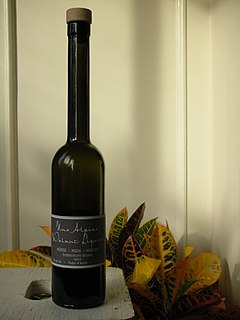
Nocino is a sticky dark brown liqueur from the Emilia-Romagna region in Northern Italy. It is made from unripe green walnuts. To make a truly authentic Nocino, one must use the most widely known walnut variety, the Juglans regia. The walnuts and the liquor have to be cut / handled using ceramic or wooden tools and placed in an alcoholic base. After steeping in spirit, the walnuts are removed and the now-black alcohol is mixed with simple syrup. Nocino has an aromatic, but bittersweet, flavor. It may be homemade; villages and even individual families often have their own recipes, including different additions like cinnamon, juniper berries, lemon or orange zest, vanilla pods, coffee beans or clove. The classic base consists of pure alcohol but Vodka can also be used. Nocino is also available commercially in bottled form. Commercially available Nocino is typically 40% alcohol by volume, or 80 proof.
Flavored liquors are alcoholic beverages that have added flavoring and, in some cases, a small amount of added sugar. They are distinct from liqueurs in that liqueurs have a large sugar content and may also contain glycerine.
Passione Nera is an Italian liqueur, similar to Sambuca. It is produced by Luxardo, who also produce Sambuca and Limoncello.
Anise drinks is a family of alcoholic drinks with unique characteristics such as:

Hierbas is a Spanish digestif.
Castello Mio is a brand of Sambuca liqueur owned and produced by Castle Brands Inc. Described as “super premium,” Castello Mio is distilled in Veneto, Italy by a family company that has been in business since the 1800s.
